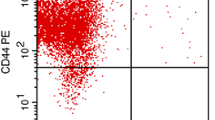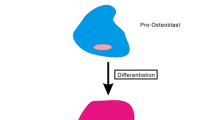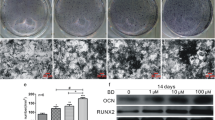Abstract
The activity of icarrin (a flavonoid from Herba epimedii) was investigated in the regulation of bone remodeling, a process coupled by osteoblast-mediated bone forming and osteoclast-mediated bone resorption. By directly co-culturing mouse bone marrow stromal cells and mouse preosteoclastic RAW264.7, and transwell co-culturing rat ovarian follicular granulosa cells (FGC), a 30 % increase in alkaline phosphatase (ALP) activity and 25 % increase in estradiol level occurred. Compared with the antiresorptive drug, alendronate, and an anabolic drug, PTH1–34, icarrin possessed all of the positive effects on the co-culture by increasing ALP activity, estradiol production and decreasing tartrate-resistant acid phosphatase activity. A similar action of icarrin occurred on co-culture of mesenchymal stem cells, mouse peripheral blood mononuclear cells, and FGC. Overall, by using a co-cultured cell-based in vitro screening assay, icarrin is suggested as a new class of dual-action therapeutic agent for osteoporosis.




Similar content being viewed by others
References
Bao JR, Yang JW, Li SF, Zhao W, Zhang Q, Yan Y (2005) Effects of icarrin on ovariectomized rats. Weisheng Yanjiu 34:191–193
Baron R (2011) Osteoporosis therapy-dawn of the post-bisphosphonate era. Nat Rev Endocrinol 8:76–78
Bian Q, Huang JH, Yang Z, Ning Y, Zhao YJ, Wang YJ, Shen ZY (2011) Effects of active ingredients in three kidney-tonifying Chinese herbal drugs on gene expression profile of bone marrow stromal cells from a rat model of corticosterone-induced osteoporosis. Zhong Xi Yi Jie He Xue Bao 9:179–185
Burmeister B, Domaschke H, Gelinsky M, Rösen-Wolff A, Hanke Th et al (2003) Co-culture of osteoblasts and osteoclasts on resorbable mineralised collagen scaffolds: establishment of an in vitro model of bone remodeling. Eur Cells Mater 5(suppl 2):18–19
Deal C (2009) Potential new drug targets for osteoporosis. Nat Clin Pract Rheumatol 5:20–27
Fong JE, Cassir N, Nihouannen DL, Komarova SV (2008) The role of osteoclasts in Osteoblast regulation. Eur Cells Mater 16(Suppl 4):22
Heinemann C, Heinemann S, Worch H, Hanke T (2011) Development of an osteoblast/osteoclast co-culture derived by human bone marrow stromal cells and human monocytes for biomaterials testing. Eur Cells Mater 21:80–93
Huang J, Yuan L, Wang X, Zhang TL, Wang K (2007) Icaritin and its glycosides enhance osteoblastic, but suppress osteoclastic, differentiation and activity in vitro. Life Sci 81:832–840
Ireland JL, Jimenez-Krassel F, Winn ME, Burns DS, Ireland JJ (2004) Evidence for autocrine or paracrine roles of alpha 2-macroglobulin in regulation of estradiol production by granulose cells and development of dominant follicles. Endocrinology 145:2784–2794
Khosia S (2001) Minireview: the OPG/RANKL/RANK system. Endocrinology 142:5050–5055
Ma HP, Ming LG, Ge BF, Zhai YK, Song P, Xian CJ, Chen KM (2011) Icarrin is more potent than genistein in promoting osteoblast differentiation and mineralization in vitro. J Cell Biochem 112:916–923
Martin TJ, Sims NA (2005) Osteoclast-derived activity in the coupling of bone formation to resorption. Trends Mol Med 11:76–81
Park EK, Kim MS, Lee SH, Kim KH, Park JY, Kim TH, Lee IS, Woo JT, Jung JC, Shin HI, Choi JY, Kim SY (2004) Furosin, an ellagitannin, suppresses RANKL-induced osteoclast differentiation and function through inhibition of MAP kinase activation and actin ring formation. Biochem Biophys Res Commun 325:1472–1480
Pederson L, Ruan M, Westendorf JJ, Khosla S, Oursler MJ (2009) Regulation of bone formation by osteoclasts involves Wnt/BMP signaling and the chemokine sphingosine-1-phosphate. Proc Natl Acad Sci USA 105:20764–20769
Rosen CJ (2003) The cellular and clinical parameters of anabolic therapy for osteoporosis. Crit Rev Eukaryot Gene Expr 13:25–38
Whyte MP, Wenkert D, Clemens KL, McAllister WH, Mumm S (2003) Bisphosphonate-induced osteopetrosis. N Engl J Med 349:457–463
Zaidi M, Iqbal J (2012) Double protection for weakened bones. Nature 485:47–48
Acknowledgments
This work was financially supported by the projects of National Natural Science Foundation of China (No. 81102739).
Author information
Authors and Affiliations
Corresponding author
Rights and permissions
About this article
Cite this article
Liu, YQ., Han, XF., Liu, T. et al. A cell-based model of bone remodeling for identifying activity of icarrin in the treatment of osteoporosis. Biotechnol Lett 37, 219–226 (2015). https://doi.org/10.1007/s10529-014-1661-8
Received:
Accepted:
Published:
Issue Date:
DOI: https://doi.org/10.1007/s10529-014-1661-8




